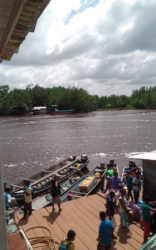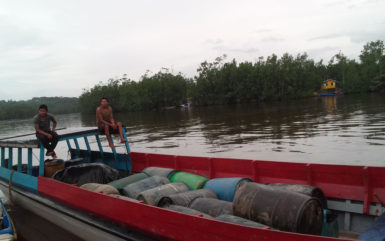Whatever the relations between Guyana and Venezuela, residents of border communities remain unrestrained in their conduct of a brisk trade in whatever goods and services they can offer each other.
From Venezuela, it is mostly oil that finds its way across the divide and into Mabaruma, with or without the knowledge of the authorities on either side. Fuel arrives at Mabaruma by boat from Venezuela to satisfy the ‘thirst’ of a community that would otherwise pay much more if it were to be flown in from Georgetown.
It is a fluid situation that changes from one period to the next. The circumstances that obtained last week and which have obtained from some time now have to do with the current economic crisis in Venezuela. Time was when the visiting boats came, sold their fuel and left. These days there is a thriving market for food in Venezuela so that rather than return empty the boats leave laden with rice, sugar, flour, milk, butter, toilet paper and farm produce among other items.
High demand in Venezuela for food from Mabaruma means that the businessmen there must find ways of moving larger volumes from Georgetown. The problem is that the ageing MV Kimbia which plied the route from Georgetown to Mabaruma is drydocked and the Lady Northcote which has taken its place lacks the capacity to move the volumes of goods necessary to sustain the trade with Venezuela. The Mabaruma businessmen would sell more to Venezuela if they had access to more.


The limits on capacity to move food from the coast to Mabaruma has given rise to the appearance of privately operated boats ready to pick up the slack. In most instances their charges to move cargo are around a third higher than what the state-run boat service charges. The fleet of small boats that do the Georgetown to Mabaruma run currently load cargo on the wharf just behind the old Giftland building.
At the beginning of 2016 one could buy fuel being imported from Venezuela at $400 per gallon. Last week the price stood at $800 per gallon. The explanation given to this newspaper at Mabaruma was that the spike in price was due to a production problem at a refinery in Venezuela. There are, however, other stories attached to the phenomenon including the creation of artificial shortages designed to push the fuel prices up. Whatever it is, the fuel trade is important to the miners, boat owners, truck, minibus and car owners and the various other businesses at Mabaruma. These days, the market in Venezuela for the agricultural produce taken back by the fuel boats is just as important to the other side.
Mabaruma is among those interior locations of Guyana that exposes the weaknesses of a hinterland development programme that has simply fallen well short of its desired objectives. Electricity, water and roads remain manifestations of a still underdeveloped community. The various communities in Mabaruma – Mabaruma Settlement, Mabaruma Township and Kumaka, among others – receive water from one or another of three wells, in turn, every other day for about two hours. The water has a dark-brownish colour; no one drinks it. Understandably, bottled water is in high demand and is imported in large quantities from both Georgetown and Venezuela. Canned juices from Venezuela are also in considerable demand in Mabaruma.
Electricity is generated by the Mabaruma Electricity Company, usually every day, from 17:00 hrs to 23:00 hrs. More recently, however, residents have been receiving power from 05:00 hrs to 07:00 hrs. That schedule does not sit well with the community’s daytime businesses. All of the business at Kumaka, near the waterfront, have generators. Their establishments simply could not survive without them.
The roads at Mabaruma are a considerable improvement on those at Port Kaituma. Still, they reflect deficiencies that are in need of considerable attention. According to reports, there is a general road rehabilitation programme underway in the community and there was evidence of this in a partially rehabilitated strip between Kumaka and the waterfront. The road in the town itself has been resurfaced. The section known as the Mabaruma Administrative Compound housing the administrative buildings in the town remains undone.
Transportation consists of mostly taxis and about half a dozen or so minibuses. The standard minibus fare for what is loosely described as a ‘short drop’ is $200. The same ride by taxi costs $1,000.
Trade
Most communities across Guyana have market days. Tuesdays and Saturdays are market days at Mabaruma. Commerce centres around the waterfront area and the Amerindian traders travel from Yarakita, some 12 miles away with their traditional produce: cassava bread, cassareep and cassava water, among others. The farmers trade in ground provision, ginger and cash crops. Farming appears to be thriving in pockets, mostly along the banks of rivers and the prices that were being asked at the market last week appeared comparable with those that obtain in Georgetown.
The fortunes of the farmers vary. Ronald Webber, a farmer from Kamwatta believes that agriculture at Kamwatta is retarded by the farmers’ inability to secure lucrative markets beyond their communities. Because of the lack of capacity of the Lady Northcote, prices are not as lucrative as the interior farmers would want them to be. Webber recalls the 1970s and 80s when the bond at the waterfront bulged with ground provision waiting to be moved to the coast. That is no longer the case.
The efficiency of the farming undertakings, Webber says, is limited by the application of inappropriate technology. Shovels, forks and hoes allow for limited production. Large-scale production requires the cultivation of larger acreages of land which means the application of levels of equipment, technology and agricultural support services that are simply not accessible to the farmers.
The waterfront traders sell their goods and purchase mostly groceries and clothing to take back with them. The trading community at Mabaruma includes ‘hustlers’ from the city who go there in search of a better market.
Entertainment would appear to be a full-time preoccupation at Mabaruma. Bars are popular and it does not appear that any particular evening is set aside for ‘hanging out.’
Inevitably, gold looms large in the fortunes of Mabaruma. There used to be a time when the commercial hum at Mabaruma was fuelled largely by the spending of miners from Port Kaituma. They travelled to Mabaruma to buy farming produce. The fortunes of the miners at Port Kaituma have changed and their spending at Mabaruma has reduced considerably.
Interestingly, it is the increased trade with Venezuela arising mostly out of the economic crisis in the neighbouring South American republic that has become one of the more viable economic opportunities for the town. That might be a discomfiting irony for the coastal administration here in Guyana but for the people of Mabaruma that is simply the way the cookie crumbles.




